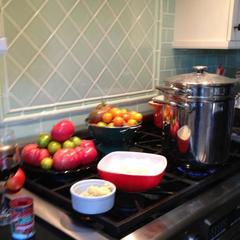5 hours ago, CantCookStillTry said:10 hour slow cooked leg of lamb with unpictured Gravy from the juices (diluted). I don't often picture my pan gravys because while they taste great - they look anemic - any ideas?
(I have to use flour to thicken to get to an Australian standard of Gravy Paste).
A couple of thoughts.
First, there's nothing wrong with using a commercial gravy browning product, if you're otherwise happy with the flavor and texture of your gravy. The one I use (Kitchen Bouquet) gets most of its color (and its smidge of flavor) from roasted mirepoix, the way I'd do it myself if I had time. I don't use it often, but when I feel the need I apply a few drops without shame or apology. Just be aware that anything more than a drop or two will give your gravy an over-darkened, artificial appearance.
Second, a dark roux requires practice and *all* of your attention while it's under construction, lest it simply be a burnt and acrid roux. I'm seldom willing to invest the time.
I'll offer up my "go-to" tip here. Take a small portion of the jus - say, a quarter-cup or so - and transfer it to a separate small pot or pan. Simmer it until it boils completely away (an occasional glance is all you need to give it, up to that point), then turn down the heat and watch carefully as it darkens to a deep mahogany. Seriously, it should be almost coffee-colored but not quite black. Now deglaze with some water or broth, or whatever other liquid you choose (I generally just use water, but it depends on the dish). Stir and scrape to get up all the browned-on bits and dissolve them into the water, which should be quite dark as a result. Stir that into either the jus (if you haven't started the actual gravy yet) or the finished gravy, which could be under construction on the next burner while you do this (that's how I usually approach it).
The browned-on "fond" will darken your gravy quite acceptably, but that's just the first benefit. A second is that you're taking the flavor of your main (lamb in this case, but it applies to anything) and enhancing it through the browning. The browning comes from the actual amines in your main dish, just as they do when you brown the meat itself, which means you're creating the very same flavors you'd get from a good, hard sear and adding them after the fact. It's a powerful technique.
You can use more of the jus if you have lots, and want to really kick up the flavor. Alternatively, you can use the same technique with a prepared broth (chicken, beef, whatever) if you haven't got enough jus. It concentrates the broth so it tastes more like the drippings from your roast, and if you then combine it with the actual jus it works really well. That's a great option when you want to stretch the gravy for a family get-together...I'll often do that at holiday meals, for example. It's a lot easier to press leftovers on everyone as they leave, if you can assure them there's plenty of gravy included. ![]()






